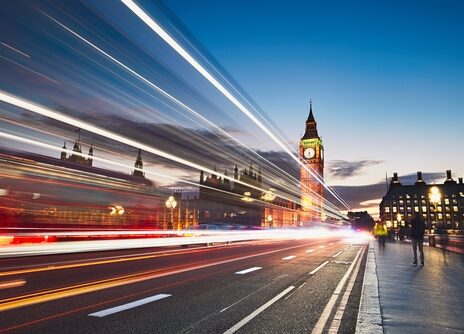
If you believe Donald Trump, Iran’s nuclear programme was “completely and totally obliterated” by the US strikes on 21 June. It was a “spectacular military success”, he declared in a live televised address to the nation that evening, “the likes of which the world has not seen in many, many decades”. Mission accomplished. End of story. Seemingly intractable problem solved. As he put it in a social media post less than 48 hours later: “CONGRATULATIONS WORLD, IT’S TIME FOR PEACE!”
Trump’s senior officials rallied behind that assessment, attempting to drown out preliminary intelligence assessments which suggested that, far from being obliterated, Iran’s nuclear capabilities had been merely set back by a few months. Pete Hegseth, the US defence secretary, berated reporters at an early-morning press conference on 25 June, demanding that they credit the president for directing “the most complex and secretive military operation in history”. “You want to call it destroyed, you want to call it defeated, you want to call it obliterated – choose your word,” he said. “This was a historically successful attack.” Instead of “undermining the success” of the American pilots by daring to question the outcome of the mission, he said journalists should “wave an American flag, be proud of what we accomplished”. Tulsi Gabbard, Trump’s director of national intelligence, weighed in on social media later that day, insisting that “new intelligence” confirmed that Iran’s nuclear facilities “have been destroyed” and that it would take “years” for the regime to rebuild.
But the problem for the Trump administration – and everyone else who might like to see the end of Iran’s nuclear programme – is that the reality is significantly more complicated than the bombast emanating from the White House. It is very likely true that the US strikes seriously damaged the country’s three biggest nuclear facilities, perhaps irreparably in the case of the sites at Fordow and Natanz, which were targeted with multiple 30,000-pound “bunker buster” bombs.
Damage, however, is not the same thing as the “fire and brimstone” the president described. Iran remains capable of producing multiple nuclear devices within a matter of months. Why? Right now, somewherein Iran, there is 400 kilogrammes of highly enriched uranium, which if enriched further to weapons-grade material is enough to make nine or ten nuclear bombs. The uranium has not been seen by International Atomic Energy Agency (IAEA) inspectors since 10 June. The “success” of Trump’s strike can be debated, but it’s no longer the question shadowing the US, Israel and Iran. The most important question of all, being asked by secret services around the world, is: where has Iran’s stockpile of highly enriched uranium gone?
The mystery of the missing uranium has dominated conversations in Washington DC in the days since the strikes after details of a preliminary report by the Defence Intelligence Agency were leaked on 24 June, assessing that the regime had likely moved most of the stockpile ahead of the attack. (The White House press secretary has dismissed the top-secret report as “flat-out wrong,” noting that it was a “low-confidence” assessment.) European intelligence agencies have similarly concluded that Iran’s uranium stockpile is likely to be largely intact, at least according to early indications. Even JD Vance, Trump’s usually combative vice-president, has appeared to concede that the uranium is unaccounted for, telling an interviewer on 22 June that it was “one of the things that we’re going to have conversations with the Iranians about”. (He hewed closer to the president’s line in subsequent interviews, telling Fox News the following day, “I do think the uranium is buried.”)
“There is no real uncertainty as to where Iran’s highly enriched uranium was,” James Acton, the co-director of the Nuclear Policy Program at the Carnegie Endowment for International Peace in Washington, told me. “We know that the highly enriched material is produced at two main centrifuge facilities – Natanz and Fordow – but it was not stored there for very long. It was taken to the tunnels at Isfahan. We know that because the IAEA was there, with inspectors on the ground literally measuring enrichment levels.” (The IAEA, the UN’s nuclear watchdog, has confirmed that its inspectors last saw the 400kg stockpile of enriched uranium, which they had verified at regular intervals in recent years as part of a previous international agreement, several days before Israel launched its assault on 13 June. The agency, however, has not publicly confirmed where the inspection took place.)
The nuclear facility at Isfahan, the site of Iran’s ancient capital, around 440 kilometres south of Tehran, is thought to include an extensive network of tunnels too deep to be targeted even by the Massive Ordnance Penetrator bombs that were dropped on Natanz and Fordow during the strikes on 21 June. That may explain why the US fired more than two dozen Tomahawk missiles at the facility from a submarine instead. “There was no attempt made to collapse the tunnels at Isfahan, almost certainly because that attempt would not have been successful,” Acton said. This has left two broad theories as to the fate of Iran’s missing uranium.
The first is that the majority of the enriched uranium was in the tunnels beneath the Isfahan complex all along, with Tehran calculating that the site was deep enough to withstand any impending strikes. Satellite imagery shows heavy vehicles near the entrances to the tunnels in the days before the attack, likely attempting to reinforce them. “The United States may have tried to collapse the tunnel entrances,” Acton said. “But while that might block the highly enriched uranium in there temporarily [if it was indeed stored there], it wouldn’t actually destroy the material if it was sitting in canisters deep underground.” One key indicator to watch for in the coming days, he told me, would be new satellite imagery showing the Iranians digging out the tunnel entrances at Isfahan. “That would be very significant.”
The second theory is that the canisters of uranium were removed from Isfahan and divided among multiple secret locations in the days before the strikes began. Iran’s foreign minister, Abbas Araghchi, had warned in a letter to the UN in May that his country would “implement special measures” to protect its nuclear materials if it was threatened with military action. And there was plenty of warning that an attack might be coming. Between the start of the Israeli campaign on 13 June and the US strikes on 21 June, Trump publicly weighed the possibility of entering the conflict in a stream of social media posts, in which, among other things, he threatened to assassinate the country’s supreme leader and demanded Iran’s “UNCONDITIONAL SURRENDER”.
“Iran was prepared for this contingency, so I think it’s likely they had a plan for how and where to move the highly enriched uranium if they thought the strikes were imminent,” Kelsey Davenport, director of non-proliferation policy at the US-based Arms Control Association, told me. Unlike the vast cascades of centrifuges needed for the enrichment process, which are fragile and difficult to move, and were likely destroyed en masse when the US bombed the sites at Fordow and Natanz, the uranium itself is relatively portable. “The enriched uranium was likely stored in canisters the size of a scuba tank, or a small propane tank,” Davenport explained. “It doesn’t require large vehicles so it can be transported fairly easily, and these small tanks could be dispersed to multiple locations. If Iran did move the material, it would be very difficult to track all of the canisters.” The director general of the IAEA, Rafael Grossi, said after the US strikes that he didn’t know if Tehran had moved all its enriched uranium, “but the evidence points to their moving out a lot of it”.
Iran’s parliament has since voted to suspend co-operation with the IAEA, ending access for the agency’s inspectors. This matters because even if Iran’s main facilities were damaged beyond use, rendering further large-scale enrichment unlikely in the short term, they could still decide to enrich their existing stockpile to 90 per cent – or weapons-grade. “Once you’ve enriched uranium to 60 per cent, getting to 90 per cent can be done quite quickly,” Davenport said. “So if Iran has retained even a portion of the 60 per cent enriched uranium, it is well set up to rebuild a nuclear programme and return to the threshold of nuclear weapons quite quickly.” Quite how quickly depends on precisely what Iran has managed to preserve, and how quickly the regime decides to move. “But if Iran was able to preserve a couple hundred IR-6 centrifuges [the country’s most advanced centrifuge] and 120kg of 60 per cent enriched uranium, they could have enough material for roughly two weapons in about three months.”
Acton agreed that the Iranians could have a limited enrichment facility within a matter of months. He said that under the Iran deal, known as the JCPOA, negotiated during Barack Obama’s presidency, the IAEA was able to count centrifuge components and monitor them. But after Trump withdrew the US from the agreement in 2018, “the IAEA lost the right to monitor those components and Iran has been stockpiling them”, he explained. “So Iran now has a triad: it has highly enriched uranium, it has centrifuge components, and it has experts.” (Israel claims to have killed at least 11 nuclear scientists during the conflict, but Acton estimated the Iranian programme probably comprised around a thousand scientists, engineers and technicians.) Acton said a small centrifuge facility could be rebuilt in any warehouse so long as it had a steady supply of electricity and the ability to instal the requisite heating and cooling systems. “They could do that literally in an industrial facility in downtown Tehran.”
Iran’s nuclear weapons programme was officially suspended in 2003 after the US invaded Iraq. Since then, the regime claims, its nuclear programme has been intended for civilian purposes, although this is disputed by the US and Israel as Iran was enriching uranium to levels far beyond the 5 per cent generally needed for a civilian nuclear reactor. But not building a weapon was a political decision, not an indication of Iran’s technical limitations, and that calculus may now change. “I think the odds of a nuclear-armed Iran have substantially risen as a result of the events of the last two weeks,” Ankit Panda, author of The New Nuclear Age: At the Precipice of Armageddon, told me. “Ali Khamenei, the supreme leader, famously has not authorised a decision to build a bomb, and I think many of those around him in Iran are probably wondering if that was just a terrible, terrible mistake, and if their friends in Pyongyang haven’t been right all along.”
He agreed that while it would take much longer to rebuild the facilities needed to enrich more uranium from scratch, the Iranians could now choose to sprint for a bomb with their existing stockpile. “I am worried about a sneak-out scenario, where the Iranians continue to lick their wounds after this devastating war, but quietly continue their work,” Panda said. “It’s a very mountainous country, and there are a lot of underground facilities, potentially including covert facilities we don’t know about.”
There was a palpable sense of exasperation among the nuclear policy experts who spoke to me for this article. The consensus was that for all the demonstrable success of the recent strikes in blowing up numerous Iranian facilities, this was never a problem with a solely military solution. “I am angry,” said James Acton. “I could never tell you that diplomacy was guaranteed to prevent Iran from getting the bomb, but it always seemed to me that it was a much more promising avenue than military action, which has only modestly eroded Iran’s capability to build the bomb, while increasing its incentives to do so.”
Shortly after our interview, Acton emailed to say that new satellite imagery had just been published showing that the Iranians had already dug out one of the entrances to the tunnel complex at Isfahan, where some of the enriched uranium stockpile could be stored. Construction vehicles were also visible around the Fordow facility. “That didn’t take long,” I remarked.
“It did not,” he replied.
[See also: The mutiny against Liz Kendall]
This article appears in the 02 Jul 2025 issue of the New Statesman, Just Raise Tax!





